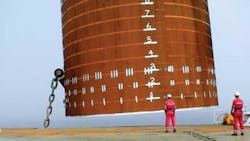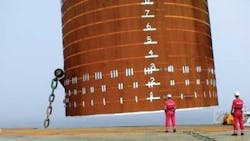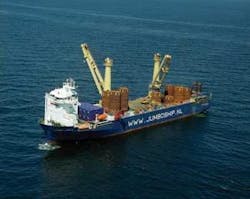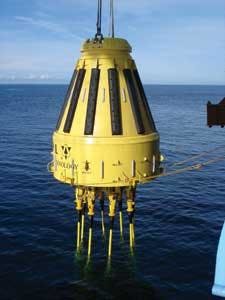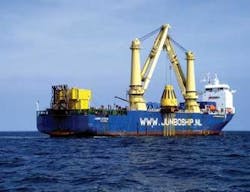World’s largest suction anchors installed offshore Boston
To meet the growing demand for gas in the northeast US, Excelerate Energy is building the Northeast Gateway Energy Bridge some 18 mi (29 km) offshore Boston.
The project foresees LNG shuttles shipping back and forth to source, and re-gasifying the LNG into the local Boston grid. LNG carriers will dock on one of the two APL submerged turret offloading (STL) buoys, which will connect via flexible risers to a subsea pipeline system.
The STL buoys will be permanently anchored offshore and, when not in use, they will float 30 m (98 ft) below the surface. On arrival on site for offloading, the LNG carrier will pull one of the STL buoys into a conical-shaped opening in its keel. A secure connection will then be made after which the re-gasification process will begin and the LNG (returned to its gaseous state) is fed into the local gas distribution grid.
System description
Each 156-metric ton (172-ton) STL buoy is held in place by eight mooring lines consisting of a chain segment (attached to the suction anchor) and 170-m (558-ft) length of spiral strand wire (SSW).
Due to the prevailing easterly weather and the shelter afforded by the coastline, the length of the 5 ¼ in. (134 mm) chain segments vary between 335 m (1,099 ft) and 710 m (2,329 ft) with the longer lengths on the east side of the mooring system.
With different soil conditions and different design loads at each anchor location, the suction anchor design varies per location. The largest suction anchor in the system measures 14 m (46 ft) wide, 11.5 m (37.7 ft) high, and weighs 142 metric tons (156 tons). The tallest suction anchor is 20 m (66 ft) high and 6.5 m (21 ft) wide.
Work scope
In January 2007, Jumbo Offshore signed an agreement with APL under which Jumbo Offshore and APL would jointly execute the installation of the two APL STL buoys and associated moorings using the DP2 heavy-lift vesselJumbo Javelin.
The agreement covered transportation of most project materials from Europe to North America, installation of the 16 mooring legs, and preparation and over-boarding of the buoys for subsequent connection to the mooring system by an anchor handling tug.
With the exception of the suction anchors, which were shipped directly from China to the local staging post of Saint John, New Brunswick, Canada, all project materials were marshalled by APL in Rotterdam for transport to site byJumbo Javelin.
In June, the vessel arrived in Rotterdam for general project preparation and loading of the project materials. With a gypsy winch installed above the hold and a chain chute to guide the chain over the vessel’s side, 8,000 m (26,247 ft) of 134-mm (5-in.) anchor chain (3,000 tons [2,722 metric tons] total weight) was loaded onto one section of the tank top and the tween deck. Subsequently, the vessel’s 2 x 900-metric ton (992-ton) cranes were used to load the eight reels of spiral strand wire and the two STL buoys.
Installation
On July 16, 2007,Jumbo Javelin arrived in Saint John, New Brunswick, and the six largest suction anchors were loaded onto the main deck and sea-fastened in the vertical for transportation.
On arrival at the installation site, and once the pre-installation survey had been completed, the first anchor was prepared for over-boarding. The lift rigging was attached to the pad-eyes on top of each suction anchor (up to 20 m [66 ft] above deck) and the suction anchor was moved to the over-boarding zone. The anchor chain was routed out of the hold, up and over the gypsy winch, over the side of the vessel, and then back onto deck. Connection of the chain to the suction anchor was achieved through use of a platform hung off from strong points on the side of the anchor. Through this procedure, the 250-kg (551-lb) pin could be safely handled and inserted to make the connection between the anchor chain and the padeye on the anchor.
Lifting and overboarding of the anchor was done in a single lift. While lowering through the splash zone, a passive heave compensation system was used to compensate for excessive dynamic loads and motions.
On touchdown of the suction anchor, an initial penetration of approximately 1 m (3 ft) resulted from the anchor’s own weight. Again, heave compensation was used to compensate for the vessel motion relative to the stationary anchor. Final penetration was achieved by means of an ROV equipped with a suction pump. Once the anchor was landed on the seabed, the ROV docked the pump suction head onto the suction flange. With the suction pump activated, pressure inside the pile drops and the external hydrostatic pressure forces the suction anchor further into the seabed. Suction anchor embedding took between six and 20 hours, depending on anchor size and local bottom soil condition.
Once the design penetration had been achieved, the anchor chain was laid in the relevant corridor. This operation was repeated for all 16 anchors. The size and number of the anchors meant that two trips were needed.
Prior to over-boarding each buoy, one end of each of the eight spiral strand wires was attached to the turret located underneath the buoy and the other end hung-off from a spreader beam.
Using a powered reel drive, each SSW was reeled off via a chute overboard and hung-off underneath an outrigger structure to the starboard side at one end. The other end of each SSW was connected to one of two spreader frames, one hung-off at the aft end and one at the fore end of the vessel. Then the 156-metric ton (172-ton) STL buoy was transferred from the deck to the pre-installed outrigger structure. Tugger winches pulled each spiral strand wire socket upwards and into a position where the spelter socket connection with the turret could be made.
Once all eight spiral strand wires had been connected to the turret of the buoy, one of the vessel’s 900-metric ton (992-ton) cranes was used to lift the 156-metric ton (172-ton) buoy with all spiral strand wires connected from the outrigger structure into the water. Following this method, possible damage to the sensitive coating of the SSWs was avoided, as all SSWs were hung-off in vertical position underneath the buoy. With all eight spiral strand mooring lines connected, the buoys were handed over to tugs for connection to the previously installed anchor chains and suction anchors.
The same procedure was followed for the second buoy.
